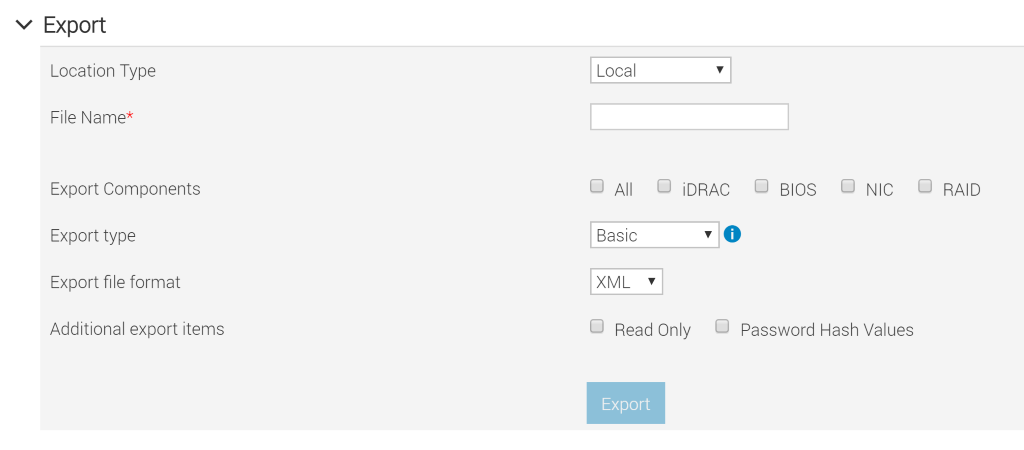Welcome
Welcome to Dell
- Place orders quickly and easily
- View orders and track your shipping status
- Create and access a list of your products
PowerEdge: How to configure, manage and deploy server profiles from the IDRAC console.
Summary: Systems Management How to Video that covers how to configure, manage and deploy server profiles from the IDRAC console.
Instructions
iDRAC Server Configuration Profiles
Duration: 00:10:20 (hh:mm:ss)
When available, closed caption (subtitles) language settings can be chosen using the CC icon on this video player.
Server Configuration Profile Basics:
What is SCP?:
-
Single file that holds configuration value for BIOS, iDRAC, NIC, Alerting, and RAID configuration
-
Can include one or many different configuration component FQDDs
-
Best used to capture a "golden image" to deploy to many servers
-
Used by multiple products for their configuration compliance, like OpenManage Enterprise and OMIVV
SCP Formatting:
-
Each section is divided by Component FQDD:
<Component FQDD="BIOS.Setup.1-1">
-
Followed by list of attributes:
<Attribute Name="LogicalProc">Enabled</Attribute>
-
Followed by closing of the Component:
</Component>
Pulling a Server Configuration Profile:
Types of Export:
-
BASIC - Non-Destruction snapshot of configuration
-
REPLACEMENT - Rarely used. Designed to restore a server to an identical configuration. Destructive and includes system-specific details like Service Tag.
-
CLONE - Capture golden image to deploy. Destructive of all attributes, including RAID. I/O Identity is not cloned
Export from the Web User Interface:
-
Configuration > Server Configuration Profile > Export

-
Configure the location type if exporting logs to a share
-
The file name does not require to include file type
-
Select Export Components
-
Password Hash values will allow user Passwords to be exported and hashed for future import to clone iDRAC local users
Export from racadm:
-
Command to pull all attributes:
racadm get –t xml –f c:\idrac.xml
-
--cloneand–includephare commonly used for a true clone
Export from Redfish:
-
Make a POST method call to:
https://iDRAC/redfish/v1/Managers/iDRAC.Embedded.1/Actions/Oem/EID_674_Manager.ExportSystemConfiguration -
Check out ExportSystemConfigurationNetworkShareREDFISH.py from the Dell Redfish GitHub for scripting example
Importing a Server Configuration Profile:
Best Practices Before Importing:
-
Remove RAID Config unless you want to include it on purpose
-
LDAP Bind Password has to be entered in manually
-
Comment or delete any values under the BIOS System Profile unless changing it to Custom
-
Do not include Boot Order unless the Bootable Devices are identical
Import from the user interface:
-
Configuration > Server Configuration Profile > Import
-
Configure shutdown type to apply the profile
-
iDRAC and EventFilter attributes do not require a reboot
Import from racadm:
-
Command to pull all attributes:
racadm set –t xml –f c:\idrac.xml
Import from Redfish:
-
Make a call to:
https://iDRAC/redfish/v1/Managers/iDRAC.Embedded.1/Actions/Oem/EID_674_Manager.ImportSystemConfiguration
Check out ImportSystemConfigurationLocalREDFISH.py from the Dell Redfish Github for scripting example
Troubleshooting Server Configuration Profile:
SYS047 - Input file for system configuration XML is not compliant with configuration schema.
- Likely the user manually edited it and the formatting is wrong
- Usually a simple edit
- Sometimes doing a clean Clone export is a quicker choice
SYS055 - Import of system configuration XML file operation completed with errors
- The profile was set but at least one attribute could not be configured
- Usually it is setting something that does not exit like Boot Order, or something with a dependency in the BIOS
- Check the Lifecycle Log for details on what did not set.
winrmcommand to get configuration results from WSMAN:
winrm i GetConfigResults "http://schemas.dell.com/wbem/wscim/1/cim-schema/2/DCIM_LCRecordLog?InstanceID=DCIM:LifecycleLog+__cimnamespace=root/dcim” -u:root -p:calvin -r:https://IPADDRESS/wsman -encoding:utf-8 -a:basic -SkipCNcheck -SkipCAcheck @{JobID="JID_123456789"}